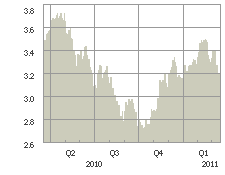Examining the short-term interest rate expectations of the futures market:
| Month / Strike | Bid Price | Ask Price | Settl. Price | Net Change | Vol. |
| + 11 AL | 0.000 | 0.000 | 98.710 | 0.000 | 0 |
| + 11 MA | 0.000 | 0.000 | 98.640 | 0.000 | 0 |
| + 11 JN | 98.660 | 98.665 | 98.670 | -0.005 | 17877 |
| + 11 SE | 98.490 | 98.500 | 98.500 | 0.000 | 25173 |
| + 11 DE | 98.310 | 98.320 | 98.310 | 0.000 | 32785 |
| + 12 MR | 98.130 | 98.140 | 98.140 | 0.000 | 15601 |
| + 12 JN | 97.950 | 97.970 | 97.960 | -0.010 | 4616 |
| + 12 SE | 97.770 | 97.790 | 97.790 | 0.000 | 945 |
| + 12 DE | 0.000 | 97.640 | 97.610 | -0.030 | 648 |
The Japanese earthquake and general instability in the marketplace has driven the June futures up from 98.545 on March 1st to 98.66 today – which is pricing in a small chance that the Bank of Canada will increase interest rates on their May 31 interest rate announcement. It is far more likely that the short term rate will be 1%.
The futures still anticipate that the year-end short-term rate will be 1.5%, so it will be interesting to see if this comes to fruition. With reports of food inflation rising (primarily due to commodity price increases), the Bank may have to make an undesirable decision to raise interest rates to stem inflation, which would have an adverse effect on the economy and stock markets.
I stated earlier I do not expect the Bank of Canada to raise interest rates until 10-year government bonds go above 3.5%, and they are presently at 3.19%:
Notably, the Canadian 10-year bond is trading at a yield of 10bps less than the US 10-year note.
